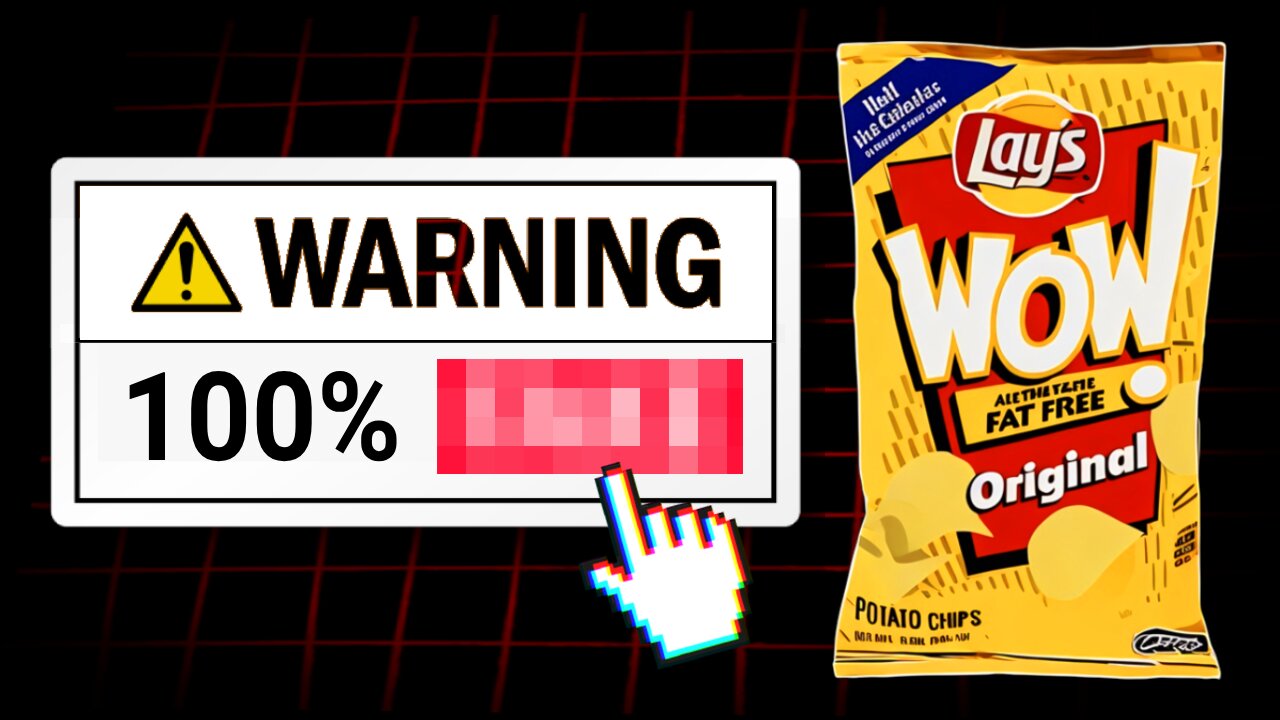Premium Only Content

The Chips That Made You TERRIFIED to Sit Down
These chips were so bad the FDA had to step in. That's how bad things got. In 1998, Lay’s made a bold move that sent shockwaves through the entire snack food industry. The company announced the release of a revolutionary new product: WOW Chips. Marketed as fat-free, guilt-free, and packed with the same salty crunch customers had come to expect from Lay’s, the chips seemed like the perfect snack. At the heart of this groundbreaking idea was a synthetic fat substitute called Olestra, a chemical compound that was supposed to replace traditional oils without sacrificing flavor or texture.
For health-conscious consumers, the concept sounded too good to be true. Eat chips. Lose the guilt. Keep the flavor. What could go wrong?
As it turns out—everything.
Backed by its parent company, Procter & Gamble, Lay’s was confident it had cracked the code to creating a healthier snack that didn’t taste like cardboard. Olestra had been approved by the FDA and was marketed as a “miracle” fat replacement. It didn’t break down like normal fats. The human body couldn’t digest it. And that was the point. Since it wasn’t absorbed, it contributed zero calories. This meant consumers could eat their favorite snacks without worrying about gaining weight or increasing cholesterol levels. On paper, WOW Chips were a dream come true.
And the numbers proved it.
In its first year, WOW Chips brought in over $400 million in sales. Supermarkets couldn’t keep them on the shelves. Consumers flocked to stores hoping to try the chips that promised full indulgence without any of the guilt. TV ads, magazine spreads, and in-store promotions sold the same message—snacking was finally healthy. Or so it seemed.
But within a year, sales dropped by 50%. And it wasn’t just a dip. It was a collapse. The public turned on the product just as quickly as they had embraced it. So, what happened?
The answer lay in the very ingredient that made WOW Chips possible: Olestra. While it offered fat-free benefits, it also brought unexpected and, frankly, horrifying side effects. Customers began to report severe gastrointestinal problems.
Everything from abdominal cramps and bloating to diarrhea became linked to the consumption of WOW Chips. But the most disturbing symptom of all? Something that would become a punchline for years to come: anal leakage.
Yes, you read that right.
Olestra was designed to pass through the digestive system without being absorbed. But because the human body couldn’t metabolize it, Olestra sometimes left behind an oily residue. That residue could seep out of the body uncontrollably. It was humiliating. It was painful. And it was not the guilt-free experience people had been promised.
The backlash was swift.
Lay’s had tried to market WOW Chips as a health-conscious snack, but the narrative quickly flipped. Instead of being the solution to unhealthy eating habits, they became a cautionary tale. Consumers felt duped. Angry. And embarrassed. The health halo that had initially made WOW Chips so appealing turned into a dark cloud of negative press, personal horror stories, and class-action lawsuits.
The FDA, which had approved Olestra, found itself at the center of a new controversy. Although the agency had deemed Olestra safe for consumption, public confidence in that approval quickly evaporated. Critics argued that the side effects should have disqualified the product from being sold at all. Others questioned how something that could cause such severe issues was ever allowed onto the market in the first place.
As the negative stories piled up, Lay’s tried to contain the damage. They issued statements defending the safety of the product. They adjusted packaging to include warning labels. But the damage was already done. Olestra became toxic—not just literally for the body, but figuratively for Lay’s reputation.
Over time, WOW Chips were quietly pulled from shelves. Other Olestra-based products disappeared, too. Once heralded as the future of snacking, they were now seen as one of the worst product failures in the history of the food industry.
What started as a revolutionary innovation ended as a cautionary tale about what happens when scientific promise collides with biological reality.
00:00 Fat-free chip breakthrough
00:30 Olestra changes everything
01:06 Sales hit £400 million
01:54 Olestra’s side effects
02:32 What Olestra actually does
04:37 The health conscious & kids
05:22 Lays Olestra’s backlash
06:04 P&G Lays PR response
07:33 The damage was done
-
 8:12
8:12
Mini Money Docs™
2 months agoChuck E. Cheese: The Most CURSED Chain in America Just Won’t Die.
18 -
 LIVE
LIVE
Steven Crowder
2 hours ago🔴Pillaging America: Lefty Celebs Prove Exactly Why Every Illegal Must Get Out
30,068 watching -
 LIVE
LIVE
Dr Disrespect
1 hour ago🔴LIVE - DR DISRESPECT - BLACK OPS 7 - BANG BANG BANG
932 watching -
 LIVE
LIVE
vivafrei
4 hours agoViva & Barnes Live with The Duran - World Politics, World News, & World War?
1,630 watching -
 1:05:29
1:05:29
The Rubin Report
1 hour agoFight Over Trump Lies Gets so Ugly It Could Be Eric Trump’s Final Appearance on This Show
4.92K11 -
 1:32:12
1:32:12
Nikko Ortiz
1 hour agoRealistic COP Simulator | Rumble LIVE
5.71K -
 LIVE
LIVE
LFA TV
12 hours agoLIVE & BREAKING NEWS! | WEDNESDAY 10/8/25
4,318 watching -
 LIVE
LIVE
The Mel K Show
56 minutes agoMORNINGS WITH MEL K -Lobbyists and Greed have Replaced the Will of We the People 10-8-25
447 watching -
 LIVE
LIVE
The Shannon Joy Show
29 minutes agoGold Surge Persists Signaling Recession, More Inflation & Potential War - Live W/ Peter Schiff!
120 watching -
 LIVE
LIVE
Grant Stinchfield
56 minutes agoThe People Have Spoken: Trump Rising, Democrats Reeling
86 watching
